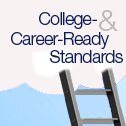A school district outside Chicago has become the first to showcase a new way of measuring students’ readiness for the workplace and college. It’s using a variety of measurements rather than relying on one test.
High School District 214, a large school system in the Chicago suburbs, has adopted the “Refining Ready!” indicators that were announced last month at the national conference of AASA, The School Superintendents Association. The organization is urging districts all over the country to try it. But the group’s current president, David R. Schuler, decided to use his own district for the system’s maiden voyage.

The new set of metrics is intended to capture a more complete and nuanced report on a students’ skills and knowledge by blending a variety of measurements.
To be considered college-ready, for instance, a student must earn a grade-point average of 2.8 out of 4.0, and then add one more factor, such as earning a C or better in an Advanced Placement course, a dual-credit class, or a remedial college English or math course. Students can also choose indicators other than those. For example, they can combine the 2.8 GPA with a C or better in Algebra II, or specified scores on an International Baccalaureate exam, or on the SAT or ACT.
To be considered career-ready, a student must have stated an interest in one of 26 nationally recognized career clusters, and met two of the requirements on a list that includes attending school 90 percent of the time, completing 25 hours of community service, completing a dual-credit career pathway course, and earning an industry credential.
Scores Don’t Tell the Whole Story
One of the things that led Schuler to put the new set of measures into practice in his district was the story that ACT exams told about his students. In high-performing District 214, where 90 percent of graduates enroll in two- and four-year colleges, only 47 percent of the class of 2015 met all four ACT college-readiness benchmarks (compared with 59 percent nationwide), which correlate with a good chance of success in credit-bearing college courses.
That picture felt incomplete to Schuler, since his district tracks students into college, and has found them returning for a second year at high rates. He became convinced that a more inclusive way of defining college readiness would tell a more complete story of what makes students successful in work or postsecondary education, he said in an interview.
Many of his fellow superintendents, too, felt that traditional college and career readiness statistics weren’t telling the full story about their students, Schuler said.
“We [at the School Superintendents’ Association] were hearing so much frustration from school district leaders across the country about the disconnect between standardized scores linked to college readiness, and what was really happening,” he said. “It was always about how many students were not prepared for college, and we knew the number of students going to college and being successful was significantly higher than that.”
The new system of metrics should produce a picture of far more students who are college- or career-ready, Schuler said.
Couldn’t it cause a problem, I asked, to declare a student college-ready under the “Redefining Ready” system, with a 2.8 GPA and a B in Algebra II, if he scores below the math college-readiness benchmarks of the SAT or ACT? Wouldn’t that set him up for a rude awakening when he sits down in a credit-bearing math course?
Schuler doesn’t think so. He noted that one of the factors a student can use in exploring his college readiness is how he performs in a remedial college course. If he takes one his junior year and doesn’t do so well, he can double down on his weak areas in 12th grade, Schuler said.
